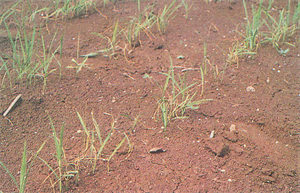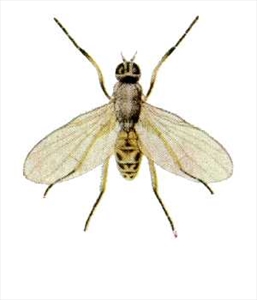Root shoot fly; it is also known as the rice seedling maggot or the corn seedling maggot.
Pacific Pests, Pathogens, Weeds & Pesticides - Online edition
Pacific Pests, Pathogens, Weeds & Pesticides
Rice shoot fly (413)
Atherigona oryzae; another species, Atherigona exigua, of unknown host, has been confused with the rice shoot fly. Atherigona oryzae is the only species known to attack rice.
Asia, Africa (Seychelles), Oceania. It is recorded from Australia, Federated States of Micronesia, New Caledonia, Papua New Guinea, Samoa, Tonga, and Vanuatu.
Rice, maize, sorghum, wheat and many wild grasses.
The maggots damage upland rice and the (dry) nurseries of lowland flooded rice. Seedlings attacked: leaves ragged, discoloured, with damaged margins; stems bored by maggots, killing the shoots and causing ‘deadheart’ symptoms (Photo 1), like those caused by stem borers (see Fact Sheets nos. 408-412). The seedling dies or survives by the production of tillers. Seedlings become resistant to attack after they have produced 5-6 leaves.
Eggs are white, darkening near the time of maturity, elongate, 1.25 mm long, laid on the leaf blades of seedlings, singly or in groups. Eggs hatch and maggots use dew drops to descend to the base of the leaf sheath where they tunnel into the tillers with their strong mouth hooks. Larvae grow to 9 mm, and are creamy-white becoming yellow with age. Pupation occurs at the base of the plant or in the soil. Pupae are contained in the last larval skin; they are reddish-brown, and about 4 mm long. The adult is a small, yellowish-grey fly, mostly 3-3.5 mm in length, with black head and thorax, and yellow abdomen with two to three pairs of black spots on the back (Photo 2). The life cycle is from 15 to more than 30 days depending on the location; in the humid tropics, the average time is 25 days.
Spread is on the wing; the adult is a strong flyer.
A serious pest of upland rice and maize, attacking seedlings up to 4 weeks old. Damage is worse in the wet season. In Mindanao, Philippines, losses of 6% were recorded from 1985-1990 in the seedling stage. Severely attacked fields have many missing plants. Plants may recover from attack but tiller density is reduced, spikelets per panicle are fewer, crop maturity is delayed, and yields reduced.
Look for the egg masses on the leaves of seedlings. Look for the deadhearts, and open the tillers to check for maggots. However, because there are several species with similar characteristics specimens should be examined by a taxonomist familiar with the genus. Identifications are based on the male sex organs.
BIOSECURITY
Countries not yet infested by the rice shoot fly should consider all likely pathways for entry, and apply quarantine measures accordingly. It is a major pest of rice, in particular. Many countries throughout Africa, the Americas and also Oceania are at risk. Pathways of introduction are likely to be via produce contaminated by pieces of stem of the hosts infested with larvae or pupae.
NATURAL ENEMIES
Trichogramma species parasitise the eggs, and Opius species (Braconid wasps) parasitise the larvae. Many kinds of spiders prey on the adults.
CULTURAL CONTROL
Before planting:
- Sow when the weather is relatively dry (in many countries this is very early in the season or very late). The fly is seasonal, passing the dry times in dormancy. Therefore, it can be avoided by adjusting the planting time.
- Increase the seedling rate to compensate for loss of tillers due to deadhearts.
- Where farmers follow a rice-maize rotation, plant rice as early as possible after planting maize (one month or less), with rates of 90-120 kg seed/ha rice.
During growth:
- Flood the crop occasionally to reduce the incidence of the shoot fly.
- If flooding is not possible, apply nitrogen fertilizer to promote recovery of the damaged plants.
RESISTANT VARIETIES
No varieties have been bred successfully for resistance.
CHEMICAL CONTROL
It is unlikely that chemical treatments would be economic for upland farmers, and are not recommended.
AUTHOR Grahame Jackson
Information from CABI Atherigona oryzae (rice shoot fly) (2017) Crop Protection Compendium. (https://www.cabi.org/cpc/datasheet/7732); and from Control of rice insect pests. IRRI. (http://www.knowledgebank.irri.org/ericeproduction/PDF_&_Docs/Control_of_rice_insect_pests.pdf). Photo 2 Atherigona oryzae Malloch. 3 Systematic Names. CSIRO and Australian Government, Department of Agriculture, Fisheries and Forestry. (http://www.ces.csiro.au/aicn/system/c_1213.htm).
Produced with support from the Australian Centre for International Agricultural Research under project HORT/2016/185: Responding to emerging pest and disease threats to horticulture in the Pacific islands, implemented by the University of Queensland and the Secretariat of the Pacific Community.





